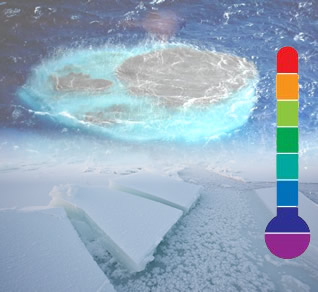Seawater freezes at a lower temperature than pure water because of the dissolved substances in it.
Pure water freezes at 0°C, whereas the temperature of seawater must drop to -1.9°C before it will freeze. (Salt is put on roads in winter for this reason, to stop the water on them from freezing.)
The temperature of the sea ranges from freezing point to about 35°C at the surface in tropical seas. Below the surface, about 300m deep, the temperature of the water declines rapidly until it levels out at a few degrees centigrade at a depth of about 550m.
This middle region is sometimes known as the Thermocline. Below it there is uniform salinity. More than three-quarters of the water in the oceans, including all water deeper than about a kilometer, has a temperature of less than 5°C.
 So, in a general global Earth view, the temperature of seawater ranges from about -1.7°C / 29°F up to about 36.1°C / 97°F. However, there are of course isolated pockets of seawater that reach near boiling temperatures where hot springs occur in seawater, or volcanic lava spews directly into the seawater, such as those found in Dominica at Soufriere where you can sit in the sea while hot water soothes your muscles.
So, in a general global Earth view, the temperature of seawater ranges from about -1.7°C / 29°F up to about 36.1°C / 97°F. However, there are of course isolated pockets of seawater that reach near boiling temperatures where hot springs occur in seawater, or volcanic lava spews directly into the seawater, such as those found in Dominica at Soufriere where you can sit in the sea while hot water soothes your muscles.